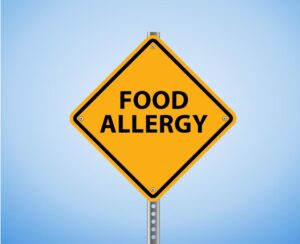Food allergies are immunological reactions that occur shortly after eating a certain food.
Even a small amount of the food that causes an allergy can trigger symptoms such as digestive problems, hives, difficulty breathing or even a life-threatening reaction known as anaphylaxis.
Food allergies are one of the many adverse reactions to food that a person can develop. Food intolerance is a less severe adverse reaction that does not involve the immune system. These intolerances may be due to a direct effect of the food itself or due to a digestive issues.
Food Allergy Symptoms

Food allergies occur when the body’s immune system reacts to specific proteins in food. Food allergic reactions vary in severity from mild symptoms involving hives and lip swelling to severe, life-threatening symptoms, often called anaphylaxis that may include fatal respiratory issues and shock.
An allergic reaction to a particular food may be uncomfortable but not severe for some people. For others, an immune response can be scary and even life-threatening. Food allergy symptoms usually develop within a few minutes to a couple of hours after eating the offending food. The most common food allergy symptoms include:
- Tingling or itching inside the mouth
- Hives and itching of the body
- Swelling of the lips, face, tongue and throat
- Wheezing and difficulty breathing
- Abdominal pain, nausea or vomiting or diarrhea
- Dizziness, lightheadedness or fainting due to a drop in blood pressure
When it is a food allergy you are at risk of a life threatening reaction if you eat the food and so you must be obsessive about reading labels and asking questions to make sure you’re avoiding it; you cannot run that risk.
Maya Jerath, MD, PhD
Causes and Detective Work
When you have a food allergy, your immune system mistakenly identifies a specific food or a substance in food as something harmful. In response, your immune system triggers cells to generate a type of antibody known as immunoglobulin E (IgE) directed against the allergy-causing food or food substance (the allergen).

The next time you eat even the smallest amount of that food, IgE antibodies sense it and signal your immune system to release chemicals such as histamine, in your body. These chemicals cause the allergy symptoms.
The big eight food allergens in the US are:
- Crustacean shellfish, such as shrimp, lobster and crab
- Peanuts
- Tree nuts, such as walnuts and cashews
- Fish
- Eggs
- Cow’s milk
- Wheat
- Soy
- Sesame while not in the “big 8 list,” is in line to be the next possible key allergen
Dr. Jerath shares, “The correlation between the consumption of a specific food and your reaction is really key to making a food allergy diagnosis. Based on that history, we can test for the presence of the IgE antibodies. On the other hand, for food intolerances, there are no tests and a food diary is the only way we can diagnose them. We ask patients to write down what they ate and their corresponding symptoms.”
Peanut Allergies
It’s not uncommon these days to find schools that have declared they are “nut-free” That means the one-time staple of lunchboxes — a peanut butter and jelly sandwich — is nowhere to be found on school grounds. That’s because peanuts can cause a life-threatening reaction in some people. If you develop a peanut allergy as a child, chances are about 85% you will have it as an adult. Similarly with shrimp and other shellfish there’s a very low likelihood you will lose this allergy as an adult.
While food allergies are much more prevalent in childhood, there’s a good chance for many allergens that as an adolescent, you will outgrow it. Something to note, allergies can be acquired later in life too…so things you used to enjoy eating when you were younger and did not cause issues, can turn into an issue.
Alpha-gal Food Allergy
Alpha-gal syndrome (AGS) is a relatively new food allergy in that it’s been identified only in the last fifteen years. The allergy itself is not new, only that allergist were unaware of it prior. It is an allergy to a carbohydrate found in lower mammals – four-legged furry animals such as cows, deer, pigs, sheep, squirrels, rabbits and yes, cats and dogs. If you develop this allergy, and eat any food products that come from these animals, you’re at risk for an allergic reaction. This allergy is unusual for three reasons:
- It is an allergy to a carbohydrate where most allergies are to a protein.
- Unlike every other food allergy where the symptoms happen rapidly…this reaction is delayed about 6 hours after eating which makes it hard for patients to figure it is the issue.
- This reaction is not 100% reproducible which also makes it hard to identify. You might not have an issue eating the same item one day to the next.
These three things have made it tricky to identify it as a food allergy. However now that allergist know alpha-gal exists, they know the questions to ask and have a blood test for it. Dr. Jerath shares, “This allergy is very unique and shows us how incomplete our knowledge of food allergies is. It teaches us the lesson that we cannot be dogmatic about our views.”
How Food Allergies Are Detected
Allergists can offer skin testing or blood tests, with skin testing being the preferred method for diagnosis. There is no treatment for the vast majority of foods, and you must avoid them to stop allergy attacks and ask lots of questions when eating, as many food allergens are hidden in food. In case you eat something you are allergic to by accident, you will want to keep an Epi-Pen and antihistamine available to treat any reaction.
“It’s very challenging and can be very painstaking to try to find it but it’s very rewarding when we find some hidden ingredient that we didn’t realize was in the dish and that was the cause for the reaction.”
Maya Jerath, MD, PhD Clinical Director for Division of Allergy & Immunology, Vice-Chair of Ambulatory Clinical Operations, Safety & Quality

Food allergies are not something to be taken lightly and are a lifestyle change that must be taken seriously. Equally challenging is the mental strain on patients. It’s stressful for adults not to know where they might run into food they’re allergic to. It can lead to social isolation and loss of quality of life due to the anxiety often experienced. The flipside, though, is for the patients who are having allergic reactions with no idea as to what the cause is, to be given a diagnosis provides some relief. Finally they feel that they’re not having random reactions and it gives them back some control…for those patients, it’s very liberating.
Dr. Jerath shares, “Our job is to provide them with as much clarity, counseling, guidance and support as we can and demonstrate that they do have the power to rescue themselves with the medicines they have. They have the power to ask questions and can live a normal and otherwise full life while staying aware of the foods they’re ingesting.”